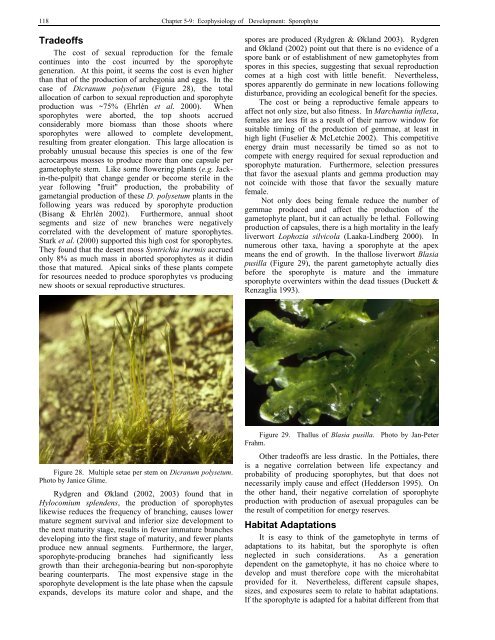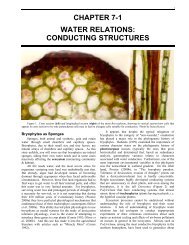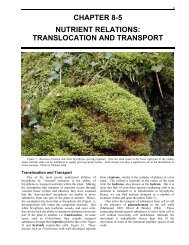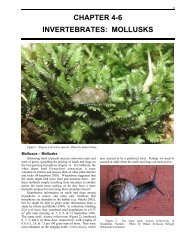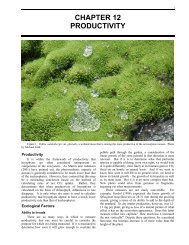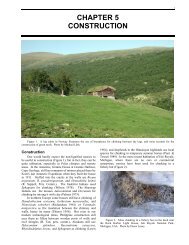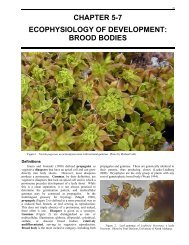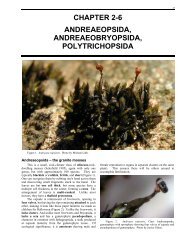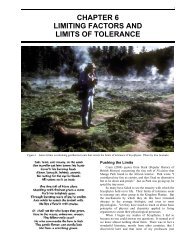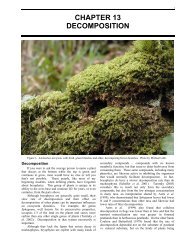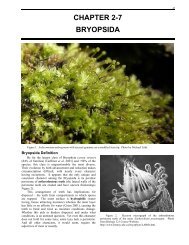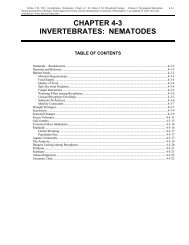chapter 5-9 ecophysiology of development: sporophyte - Bryophyte ...
chapter 5-9 ecophysiology of development: sporophyte - Bryophyte ...
chapter 5-9 ecophysiology of development: sporophyte - Bryophyte ...
You also want an ePaper? Increase the reach of your titles
YUMPU automatically turns print PDFs into web optimized ePapers that Google loves.
118 Chapter 5-9: Ecophysiology <strong>of</strong> Development: SporophyteTrade<strong>of</strong>fsThe cost <strong>of</strong> sexual reproduction for the femalecontinues into the cost incurred by the <strong>sporophyte</strong>generation. At this point, it seems the cost is even higherthan that <strong>of</strong> the production <strong>of</strong> archegonia and eggs. In thecase <strong>of</strong> Dicranum polysetum (Figure 28), the totalallocation <strong>of</strong> carbon to sexual reproduction and <strong>sporophyte</strong>production was ~75% (Ehrlén et al. 2000). When<strong>sporophyte</strong>s were aborted, the top shoots accruedconsiderably more biomass than those shoots where<strong>sporophyte</strong>s were allowed to complete <strong>development</strong>,resulting from greater elongation. This large allocation isprobably unusual because this species is one <strong>of</strong> the fewacrocarpous mosses to produce more than one capsule pergametophyte stem. Like some flowering plants (e.g. Jackin-the-pulpit)that change gender or become sterile in theyear following "fruit" production, the probability <strong>of</strong>gametangial production <strong>of</strong> these D. polysetum plants in thefollowing years was reduced by <strong>sporophyte</strong> production(Bisang & Ehrlén 2002). Furthermore, annual shootsegments and size <strong>of</strong> new branches were negativelycorrelated with the <strong>development</strong> <strong>of</strong> mature <strong>sporophyte</strong>s.Stark et al. (2000) supported this high cost for <strong>sporophyte</strong>s.They found that the desert moss Syntrichia inermis accruedonly 8% as much mass in aborted <strong>sporophyte</strong>s as it didinthose that matured. Apical sinks <strong>of</strong> these plants competefor resources needed to produce <strong>sporophyte</strong>s vs producingnew shoots or sexual reproductive structures.spores are produced (Rydgren & Økland 2003). Rydgrenand Økland (2002) point out that there is no evidence <strong>of</strong> aspore bank or <strong>of</strong> establishment <strong>of</strong> new gametophytes fromspores in this species, suggesting that sexual reproductioncomes at a high cost with little benefit. Nevertheless,spores apparently do germinate in new locations followingdisturbance, providing an ecological benefit for the species.The cost or being a reproductive female appears toaffect not only size, but also fitness. In Marchantia inflexa,females are less fit as a result <strong>of</strong> their narrow window forsuitable timing <strong>of</strong> the production <strong>of</strong> gemmae, at least inhigh light (Fuselier & McLetchie 2002). This competitiveenergy drain must necessarily be timed so as not tocompete with energy required for sexual reproduction and<strong>sporophyte</strong> maturation. Furthermore, selection pressuresthat favor the asexual plants and gemma production maynot coincide with those that favor the sexually maturefemale.Not only does being female reduce the number <strong>of</strong>gemmae produced and affect the production <strong>of</strong> thegametophyte plant, but it can actually be lethal. Followingproduction <strong>of</strong> capsules, there is a high mortality in the leafyliverwort Lophozia silvicola (Laaka-Lindberg 2000). Innumerous other taxa, having a <strong>sporophyte</strong> at the apexmeans the end <strong>of</strong> growth. In the thallose liverwort Blasiapusilla (Figure 29), the parent gametophyte actually diesbefore the <strong>sporophyte</strong> is mature and the immature<strong>sporophyte</strong> overwinters within the dead tissues (Duckett &Renzaglia 1993).Figure 28. Multiple setae per stem on Dicranum polysetum.Photo by Janice Glime.Rydgren and Økland (2002, 2003) found that inHylocomium splendens, the production <strong>of</strong> <strong>sporophyte</strong>slikewise reduces the frequency <strong>of</strong> branching, causes lowermature segment survival and inferior size <strong>development</strong> tothe next maturity stage, results in fewer immature branchesdeveloping into the first stage <strong>of</strong> maturity, and fewer plantsproduce new annual segments. Furthermore, the larger,<strong>sporophyte</strong>-producing branches had significantly lessgrowth than their archegonia-bearing but non-<strong>sporophyte</strong>bearing counterparts. The most expensive stage in the<strong>sporophyte</strong> <strong>development</strong> is the late phase when the capsuleexpands, develops its mature color and shape, and theFigure 29. Thallus <strong>of</strong> Blasia pusilla. Photo by Jan-PeterFrahm.Other trade<strong>of</strong>fs are less drastic. In the Pottiales, thereis a negative correlation between life expectancy andprobability <strong>of</strong> producing <strong>sporophyte</strong>s, but that does notnecessarily imply cause and effect (Hedderson 1995). Onthe other hand, their negative correlation <strong>of</strong> <strong>sporophyte</strong>production with production <strong>of</strong> asexual propagules can bethe result <strong>of</strong> competition for energy reserves.Habitat AdaptationsIt is easy to think <strong>of</strong> the gametophyte in terms <strong>of</strong>adaptations to its habitat, but the <strong>sporophyte</strong> is <strong>of</strong>tenneglected in such considerations. As a generationdependent on the gametophyte, it has no choice where todevelop and must therefore cope with the microhabitatprovided for it. Nevertheless, different capsule shapes,sizes, and exposures seem to relate to habitat adaptations.If the <strong>sporophyte</strong> is adapted for a habitat different from that


